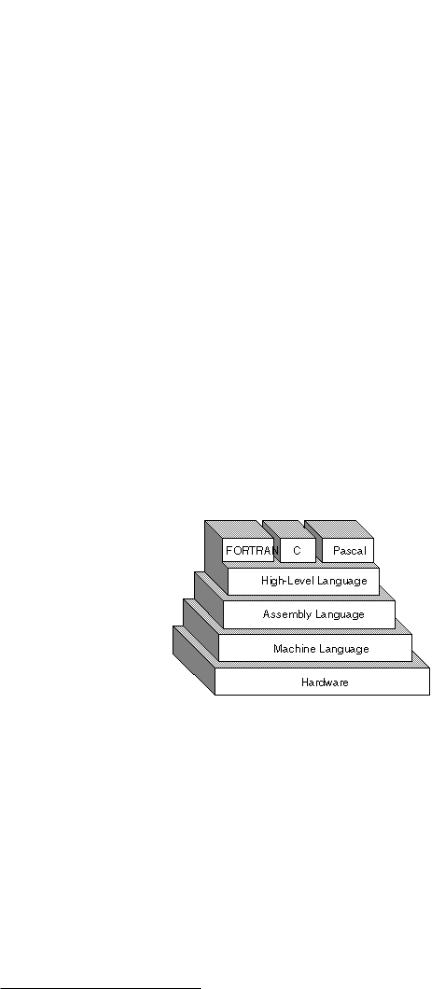
Языки Программирования Исходник
.pdf
Lesson 24 — 25 |
|
|
1. Translate the vocabulary. |
|
|
to define |
|
environment |
|
||
to enable |
|
purpose |
to specify |
|
to vary |
circumstance |
|
to comprise |
to substitute |
|
streamlined |
source code |
|
to eliminate |
runtime |
|
sophisticated |
to interact |
|
|
2. Read and translate the text. |
|
|
Programming Languages
A programming language or computer language is a standardized communication technique for expressing instructions to a computer. It is a set of syntactic and semantic rules used to define computer programs. A language enables a programmer to precisely specify what data a computer will act upon, how these data will be stored/transmitted, and precisely what actions to take under various circumstances.
The term programming language usually refers to high-level languages, such as BASIC, C, C++, COBOL, FORTRAN, Ada, and Pascal. Each language has a unique set of keywords (words that it understands) and a special syntax for organizing program instructions.
High-level programming languages, while simple compared to human languages, are more complex than the languages the computer actually understands, called machine languages. Each different type of CPU has its own unique machine language.
Lying between machine languages and high-level languages are languages called assembly languages. Assembly languages are similar to machine languages, but they are much easier to program in because they allow a programmer to substitute names for numbers. Machine languages consist of numbers only.
Lying above high-level languages are languages called fourth-generation languages (usually abbreviated 4GL). 4GLs are far removed from machine languages and represent the class of computer languages closest to human languages.
Regardless of what language you use, you eventually need to convert your program into machine language so that the computer can understand it. There are two ways to do this:
1

•compile the program
•interpret the program
If the translation mechanism used is one that translates the program text as a whole and then runs the internal format, this mechanism is spoken of as compilation. The compiler is therefore a program which takes the human-readable program text (called source code) as data input and supplies object code as output. The resulting object code may be machine code which will be executed directly by the computer's CPU, or it may be code matching the specification of a virtual machine.
If the program code is translated at runtime, with each translated step being executed immediately, the translation mechanism is spoken of as an interpreter. Interpreted programs run usually more slowly than compiled programs, but have more flexibility because they are able to interact with the execution environment.
During the last few decades, a large number of computer languages have been introduced, have replaced each other, and have been modified/combined. Although there have been several attempts to make a universal computer language that serves all purposes, all of them have failed. The need for a significant range of computer languages is caused by the fact that the purpose of programming languages varies from commercial software development to scientific to hobby use; the gap in skill between novices and experts is huge and some languages are too difficult for beginners to come to grips with; computer programmers have different preferences; and finally, acceptable runtime cost may be very different for programs running on a microcontroller and programs running on a supercomputer.
There are many special purpose languages, for use in special situations: PHP is a scripting language that is especially suited for Web development; Perl is suitable for text manipulation; the C language has been widely used for development of operating systems and compilers (socalled system programming).
3.Be ready to talk about programming languages and your favourite one.
4.Open the brackets using the necessary form of the Gerund.
1.Why do you avoid (to speak) to me? 2. She tried to avoid (to speak) to. 3. The doctor insisted on (to send) the sick man to hospital. 4. The child insisted on (to send) home at once. 5. Do you mind him (to examine) by a heart specialist? 6. He showed no sign of (to recognize) me.
7.She showed no sign of (to surprise). 8. He had a strange habit of (to interfere) in other people's business. 9. I was angry at (to interrupt) every other moment. 10. He is good at (to repair) cars.
11.He was very glad of (to help) in his difficulty. 12. On (to allow) to leave the room, the children immediately ran out into the yard and began (to play). 13. In (to make) this experiment, they came across some very interesting phenomena. 14. The results of the experiment must be checked and rechecked before (to publish). 15. David was tired of (to scold) all the time.
16.The watch requires (to repair)1. 17. The problem is not worth (to discuss)1. 18. Jane Eyre remembered (to lock) up in the red room for (to contradict) Mrs. Reed.
2
